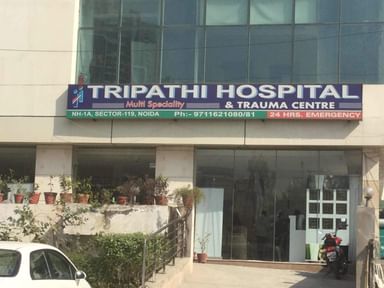Tripathi Hospital
Ophthalmologist Clinic
About Clinic
Our goal is to offer our patients, and all our community the most affordable, trustworthy and professional service to ensure your best health....read more
Clinic Timing
Clinic Location
Videos
Hello everyone,
I am Dr. Dipankar Anand. I would like to discuss with you about the problems of diabetes in the eye, particularly Diabetic Retinopathy. So if we talk about diabetes it can affect the eyes in many ways. Starting with dryness increased dryness of the eyes and early cataract glaucoma and finally something known as diabetic retinopathy. So let's talk about the more concerning part of all of these which is diabetic retinopathy. So let's talk about diabetic retinopathy. We must all understand that all diabetics do not get diabetic retinopathy. But according to a recent survey, it has been shown that at least 80% of all the diabetics will have diabetic retinopathy after 20 years of the disease. So it is important to understand the pathophysiology of diabetic retinopathy. In diabetic retinopathy there are 2 major factors of pathophysiology which are responsible for the disease.
Number one is the vessels the normal vessels of the retina they become leaky and because of the leakage, there is leakage of fluid into the retina which causes Macular edema. And the 2nd most important factor of pathophysiology of the retina which leads to diminishing vision is vitreous hemorrhage. Why does this vitreous hemorrhage occur we should all know that. The reason has been that because of this is all because new vessels that are been formed in retina which are more fragile than the normal vessels. And these blood vessels they rupture and leak blood into the vitreous cavity causing something known as vitreous hemorrhage which results in the sudden and gross diminishing of vision in the eye. So what are the treatment modalities of diabetic retinopathy? There are various modalities of treatment but we should all understand one thing that a regular checkup and a detailed examination of the retina is of utmost importance in all diabetic patients and especially in patients having diabetes for more than 10 years. Now coming back to the treatment modalities so all diabetic patients must get their eyes checked every once in a year.
And it should be a detailed examination with the indirect ophthalmoscope examination followed by something known as the optical coherence tomography which basically helps us detect even the minute changes of diabetic retinopathy in the eye and if suppose some changes are present in the retina one should go ahead with something known as Fluorescein Angiography to find out the leaky vessels and if required laser should be done as soon as possible. So once diabetic retinopathy has been diagnosed in a patient what are the treatment modalities. Well, the treatment modalities usually depend on what kind of pathology the patient has.
The most commonly used injections of all of them are Lucentis or Excentrix which is an anti-vascular endothelial growth factor which basically helps to reduce the fragile new vessels and redress it completely so that the future chance of vitreous hemorrhage is negligible and secondly it also decreases the macular edema of the patient. The one thing which needs to be understood is that repeated injections of this intravitreal injections might be required in some patients in order to keep the macula completely dry. And second of all other treatments also include intravitreal injections of steroids but that again has its pros and cons it can cause glaucoma cataract. And there are lasers present to treat macular edema but those two if it is not in all cases only in few cases. Now when are lasers required? This is one more important factor which you all should know. Laser is required in cases something known as proliferative diabetic retinopathy. In few cases of diabetic retinopathy when I explained new vessels are formed in the periphery so those new vessels need to be lasered in order to stop them from bleeding at a later stage.
So something known as pan retinal photocoagulation is required in patients who have been diagnosed with proliferative diabetic retinopathy after a detailed check up with Fluorescein Angiography has been done in that patient. At very later stage when vitreous hemorrhage occurs in a patient and that too it is not resolved only in those cases and in cases of tractional retinal detachment surgery in the form of vitrectomy pars plana vitrectomy with a laser might be required. So of all the things, it is more emphasis should be given on the control of diabetes on the control of blood sugar in all the patients whether it is been controlled properly with medications and whether proper exercise is been done these cant be emphasized more. The treatment is obviously required in cases of a patient who has the disease but blood sugar control should be done in all cases and proper regular check-up must be done. The patient should follow up with the physician and proper medication should be taken.
Thank you!

